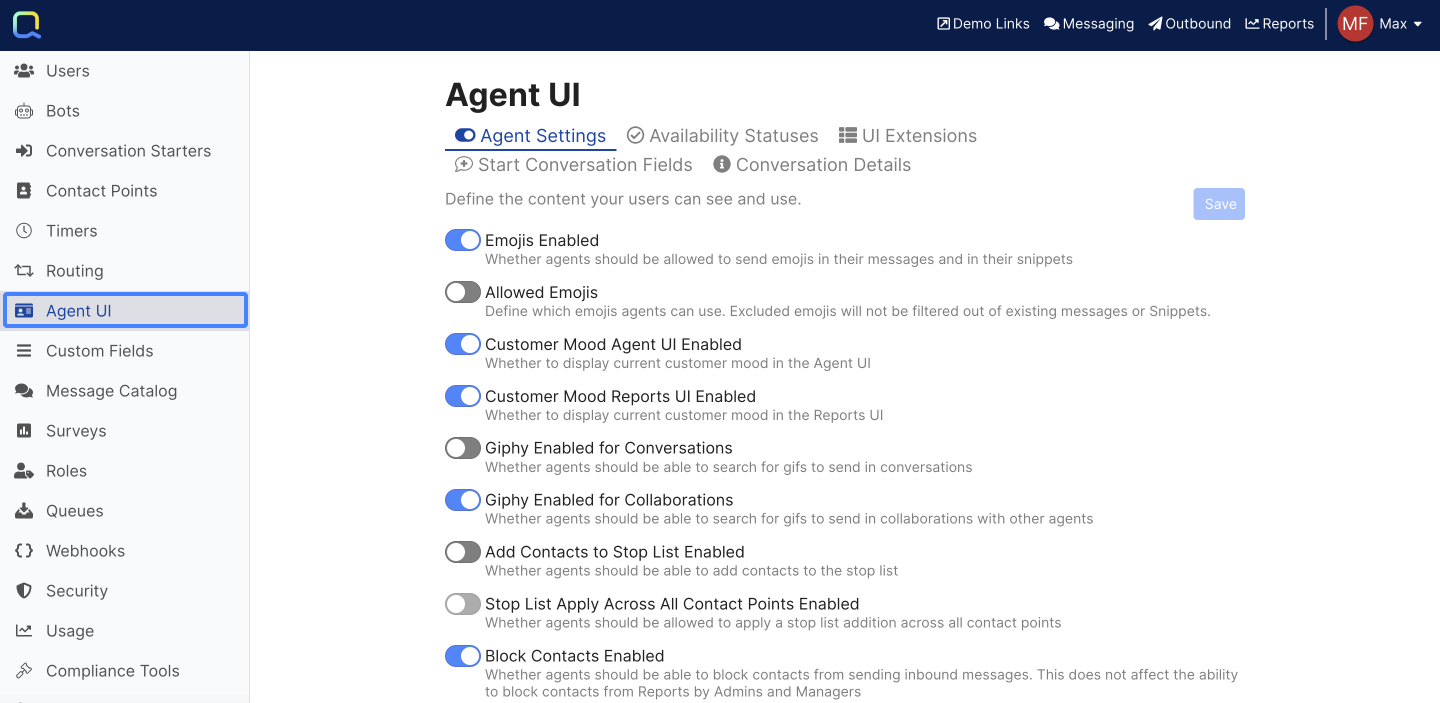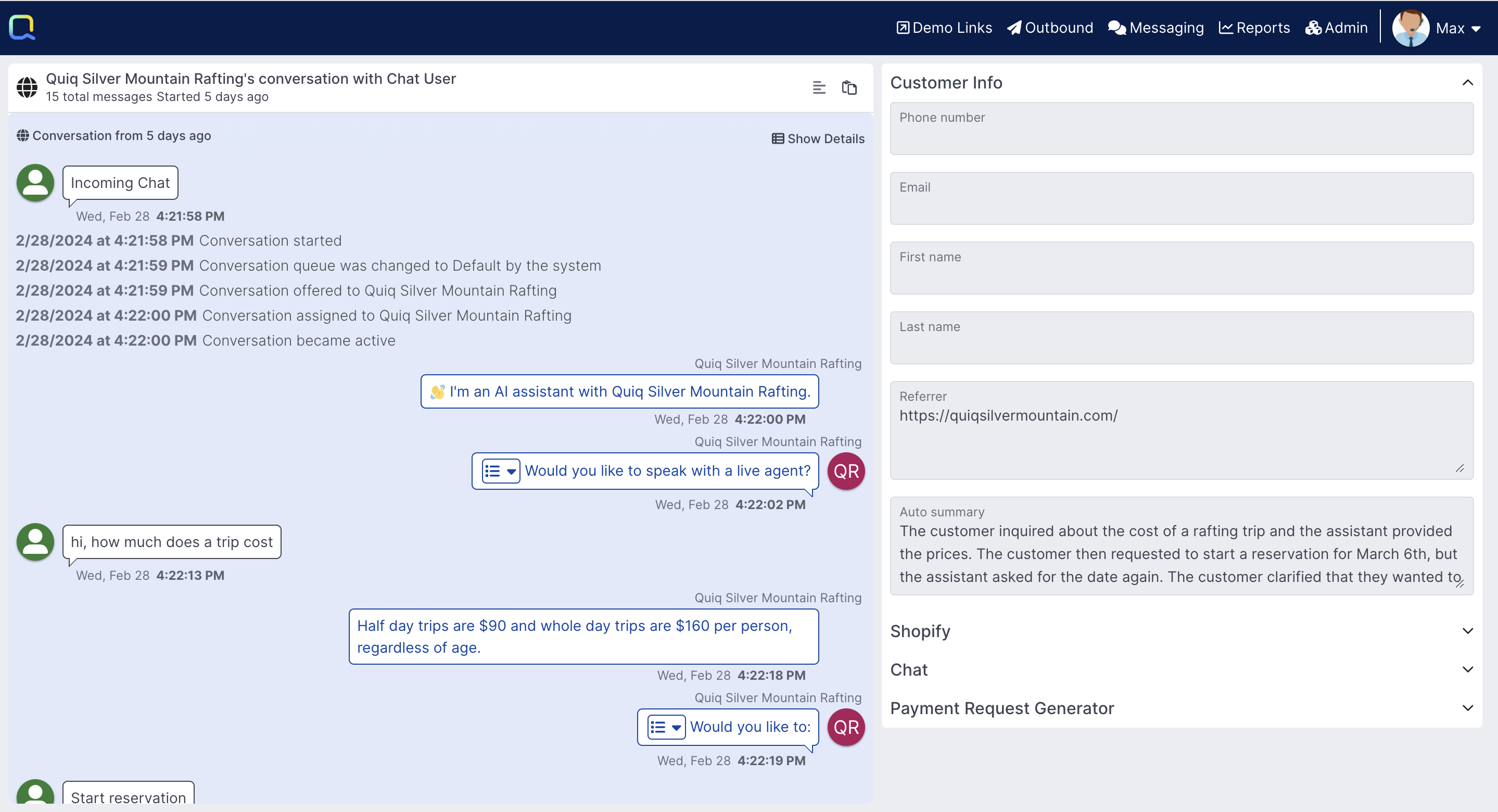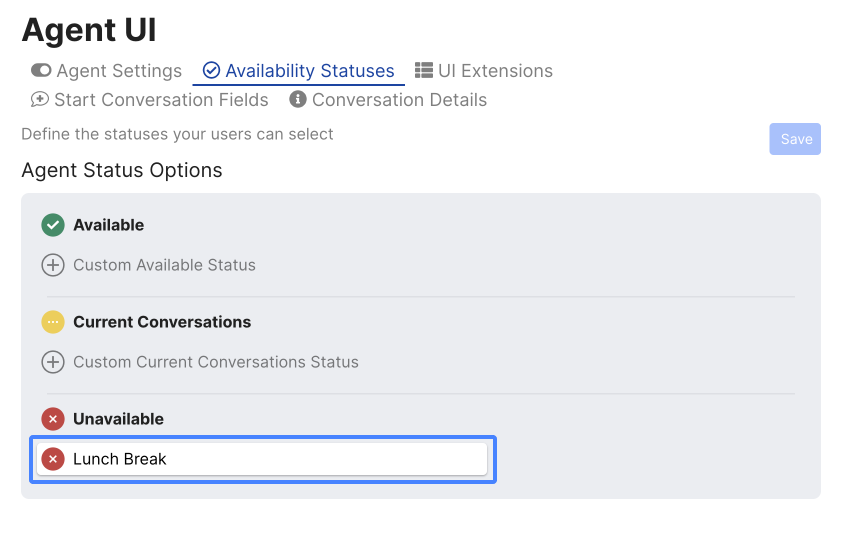Agent UI
Overview
Agent UI enables an admin to configure how the Messaging interface appears to agents.
Agent Settings
Toggle the listed settings to allow or disallow the use of the emojis, giphys, and stop and block selections. These settings are universal across the application.

Emojis Enabled
Master switch to enable the use of emojis by agents. This does NOT block emojis customers send in the conversation. Turning this off removes the ability to add emojis to conversations, collaborations, and snippets.
Allowed Emojis
Allows the selection of allowed or disallowed emojis. Certain emojis may be removed to ensure an agent does not send an inappropriate emoji. If Included is selected, only the chosen emojis will be available to agents. This allows a small, safe set of emojis for agent use.
Customer Mood Agent UI Enabled
Whether to display current customer mood in the Agent UI
Customer Mood Reports UI Enabled
Whether to display current customer mood in the Reports UI
Giphy Enabled for Conversations
Most messaging applications support Gif search and insertion into conversations. This option can provide a more engaging and personal experience, but may be too informal for some organizations.
Giphy Enabled for Collaborations
As above, this setting allows gif insertion into internal facing collaborations. This is enabled by default and allows agents to provide expressive gifs specifically in the collaboration. Collaborations are NOT visible to the customer.
Add Contacts to Stop List Enabled
Allows an agent to add a customer to the Stop list (essentially opting the customer out of messages). This opt out takes place as soon as the exiting conversation is complete. This provides agents the means to opt a customer out at the point of contact vs. submitting to an Admin user.
Block Contacts Enabled
This option allows an agent to block incoming messages from the given contact, after marking the conversation as spam. The block takes place immediately. See also Agent Blocking and also Manager Blocking.
Copy Conversation URL Enabled
When enabled, this allows Admins, Staff Admins and Managers to easily copy and share conversation URLs with other uses who can access that conversation. A Copy Conversation URL button will appear when viewing conversations:

If you'd like Agents to have the ability to view and copy conversations, there is an additional Copy Conversation URL Enabled for Agents toggle:

When viewing conversations from this URL, users are taken to a special conversation view that presents a read only view of the conversation and any additional information in the right hand extension area:

Availability Statuses
When a custom availability status is created, it's associated with one of the standard Unavailable, Current Conversations or Unavailable statuses. Custom statuses can be set to be "enabled", which means that they'll be visible to users in the Quiq application, or "disabled", to hide the status if it isn't needed anymore, or shouldn't be visible yet. Custom statuses can be toggled between Enabled/Disabled as needed.
Enabled custom statuses are ordered alphabetically within each standard status type by default in the Availability Statuses editor, but custom statuses can be reordered by clicking on the status's icon and dragging it to the desired location. Statuses can only be reordered within their original status type - so for example, you can't move a custom status that was originally created for the Unavailable status type to the Available status type. Custom status labels can be edited at any time (the labels for the three standard statuses cannot be edited), but the ID (which can be viewed by hovering over the status) always remains set to the original value.

A Custom Unavailable Status being added for "Lunch Break"
The Missed Invitation Status & Missed Response Status fields in the Admin > Routing page are both set to the standard Current Conversations status by default, but all Current Conversations-type custom statuses are available in the field menus, so you can select the status that agents are automatically set to when Invitation or Response timeouts are missed.
UI Extensions
Customer name, phone number, and messaging handle are useful elements in allowing agents to provide personalized assistance to customers. These basic elements are stored in the Quiq system and once entered, may be displayed for any future conversation with the customer. These fields may be configured for display or not as needed, and are displayed to the right side of the conversation pane. These fields are typically not displayed for CRM integrated systems as this data resides in the CRM and is not propagated back to Quiq.
In addition to (or in some cases, instead of) the Quiq fields, external system fields may be displayed by adding a securely hosted (HTTPS) webpage to the Quiq application. Some examples of usage would include order management system lookups associated to mobile numbers or CRM contact pages. Implementing these extensions requires system integration expertise. Quiq developers have released a UI extension SDK on GitHub to streamline these integrations.
Start Conversation Fields
For sales or other use cases where agents often initiate conversations, the ability to set conversation custom fields when starting the conversation may be beneficial. Conversation custom fields can be created in the Custom Fields editor. Available fields may be selected and subsequent fields will then be available.
Conversation Details
Customize the content that displays in the Show Details dialog within conversation transcripts - independently of UI Extensions
The Conversation Details tab contains a Use UI Extensions Configuration toggle button, enabled by default, which allows you to keep the default behavior of displaying the sections & fields defined in the UI Extensions tab in the Show Details dialog. When that toggle button is enabled, the editor displays a read-only preview of what will display in the Show Details dialog - the default content that has always displayed at the top of the dialog, followed by the sections and fields you currently have defined in the UI Extensions tab.
When the Use UI Extensions Configuration toggle button is disabled, the content in the preview becomes editable, and default content displays that you can then customize by adding or removing sections and fields. You can also drag & drop fields to reorder the content within the same section, and reorder sections with either drag & drop or the up/down arrow buttons. The customized content you define will then display in the Show Details dialog within conversation transcripts for all agents, independent of the content that you have defined in the UI Extension tab to display in the right-hand side section of a conversation.
Updated about 2 months ago
